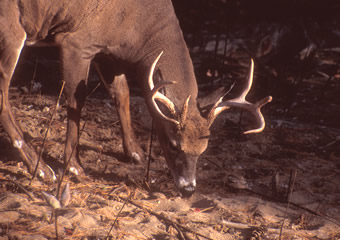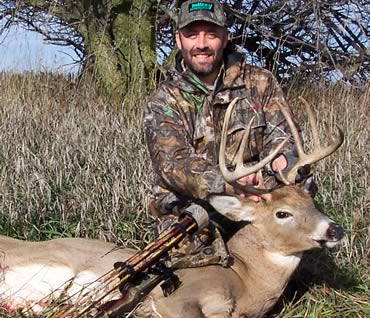A bare patch of ground can be a valuable piece of deer hunting real estate.
Sneaking through the dense conifers of Anticosti Island, I caught flash of brown and a glimpse of movement off to my left. Deer! My guide had dropped me off hours earlier with a map of what would be my exclusive territory for the day. Besides me, the only living thing there bigger than a fox would be a deer.
I raised my rifle and peered through the scope. Antlers! The sight sent a second charge of adrenaline surging through my body. Unfortunately, head and antlers were about all I could see.
I slowly eased around the trunk of a big spruce, and there stood the buck, now 80 yards away, raking his antlers through some overhanging branches. I eased up my rifle on a dead limb and waited. Then the buck stepped forward. It wasn’t much, but it was enough to expose all of his neck. At the shot, the buck dropped in his tracks.
Walking up to the fallen buck, it all became clear. Twigs and limbs of the overhanging branch were broken, obviously from repeated thrashings. The ground where the lifeless buck lay was bare earth, rippled with slotted tracks. The air was filled with a pungent, musky aroma. I’d literally dropped the buck in an active scrape.
It was a scenario many hunters envision but rarely realize. You find a scrape, set up over it and imagine taking the bull of the woods when he comes in to tend it. Unfortunately, it rarely ever works out that way, for a number of reasons. However, that doesn’t mean you should abandon hunting over scrapes. It just means you should learn more about which scrapes are better to hunt, and when it’s best to hunt them.
What’s a Scrape?
A buck ambles down a woodland trail. He stops and paws the ground several times with his front feet, kicking back the duff and exposing bare soil. Then he steps forward, grinding the dark-stained tarsal glands on his hind legs together as he urinates. The golden liquid runs down his legs, mixing with waxy secretions from his tarsals and falls onto the bare earth. Whether intentional or not, he’s just sent a message.
When it comes to scrapes and their usefulness to hunters, there’s almost as much misinformation out there as good information. For example, most hunters believe mature bucks make scrapes. That’s true; however, young bucks also scrape. Even does visit scrapes on a fairly regular basis.
 Some of the misunderstanding stems from the fact there are different types of scrapes. From research, we know scraping activity is most intense just before the peak of rut. That implies it is somehow related to courtship. For the most part, it is. However, some scraping occurs well before the breeding or courting phases of the rut, during what we sometimes refer to as pre-rut when bucks are still sorting out dominance. Like an angry bull, one might paw the ground merely as a sign of aggression or to express dominance. From a hunting perspective, this scrape is of little value. It tells us a buck or bucks are or were present, but it will likely never be revisited.
Some of the misunderstanding stems from the fact there are different types of scrapes. From research, we know scraping activity is most intense just before the peak of rut. That implies it is somehow related to courtship. For the most part, it is. However, some scraping occurs well before the breeding or courting phases of the rut, during what we sometimes refer to as pre-rut when bucks are still sorting out dominance. Like an angry bull, one might paw the ground merely as a sign of aggression or to express dominance. From a hunting perspective, this scrape is of little value. It tells us a buck or bucks are or were present, but it will likely never be revisited.
As days grow shorter, physiological changes trigger an increase in testosterone that motivates bucks to begin scraping. They kick away the duff, then rub-urinate (grinding their tarsal glands together and peeing down their legs so the urine and tarsal scents combine before running into the bare soil, where they remain as an olfactory signpost). The message is not entirely clear to us. However, it’s very likely that the buck is signaling that he’s ready to breed. He might also be communicating dominance or merely announcing his presence or, perhaps, all of the above.
Regardless, bucks are more likely to revisit these signpost scrapes, though a large proportion might only be tended once or infrequently. They’re easily distinguishable from display scrapes because they have an overhanging licking branch, a type of rub, which we discussed in detail in the August issue. The licking branch’s importance in communication might exceed that of the scrape it overhangs. Together, they’re a dynamic duo of deer dialect.
Before you hang a stand over the next fresh scrape you find, you should know research tells us that roughly 85 percent of scraping occurs at night. While it can, and does happen, your odds of shooting a buck over a scrape are pretty slim. However, hunting near an active scrape can be productive.
Not every deer that visits the scrape will pee or scrape the ground; some just come by to scent-check it. Those that approach it will tend the licking branch, smelling it first — presumably to see who’s been by recently — then rubbing it with their forehead and pre-orbital glands, depositing scent from each.
A more likely scenario is for a buck to scent-check the scrape from downwind, in the safety of thick cover, to see if a hot doe has read his calling card. If you’re hunting over the scrape, you might never see or hear him. Worse, he might see or smell you and probably won’t return. Set up downwind and you might catch him looking the other way.
 Even signpost scrapes are not all the same. Once a buck begins the seeking phase, he expands his home range considerably and travels far outside his usual haunts. As he does, he scrapes, because he’s programmed to do so. He might never revisit that scrape. It’s kind of like leaving your business card in the jar at a restaurant while vacationing far from home. Even if they pick your name for a free meal you’ll probably never go back.
Even signpost scrapes are not all the same. Once a buck begins the seeking phase, he expands his home range considerably and travels far outside his usual haunts. As he does, he scrapes, because he’s programmed to do so. He might never revisit that scrape. It’s kind of like leaving your business card in the jar at a restaurant while vacationing far from home. Even if they pick your name for a free meal you’ll probably never go back.
That’s why it’s a good idea to keep tabs on the scrapes near where you intend to hunt. Check to see if, and how often, they’re reopened. The trick is scouting often enough to gather fresh intel, but not so often that your presence becomes a disturbance. Remember, a deer’s nose is supersensitive. If he can tell from 110 yards that a doe passed by in the last 24 hours, there’s a good chance he’ll also be able to tell that you’ve been by.
This is where scouting cameras can be really beneficial. You don’t have to check them as often, and you can get a detailed chronological log of scrape use. With more recent versions that transmit images, you can even get real-time data without visiting the site. In either case, it’s best to use cameras with an infrared option for nighttime photography. Otherwise, a flash could scare deer off the scrape, ruining a perfectly good setup.
Primaries
There is another benefit of extensively scouting your hunting area for scrapes. I was doing an environmental assessment on a piece of property one fall that required me to walk nearly every square foot with a set of plans. As I did, I began to notice lots of scrapes. Ever the opportunist, I marked each one on the plans. (This was before GPS had been invented.) Looking at the plans later that night, I noticed a pattern, almost like a wagon wheel. The next morning, I went straight to the hub, where I found a huge scrape and heavy trails leading in several different directions. Unfortunately, the bucks started chasing that day, so I never got to hunt over it.
It taught me a lesson, and since then I’ve found two similar situations — huge scrapes that appeared to be a deer version of Grand Central Station. These hubs, sometimes called primary scrapes, can be hunting gold mines. They’re not just made for breeding purposes; deer seem to use them throughout the fall.
Heirlooms
Another type of scrape that is valuable to the hunter is traditional, or what I call heirloom, scrapes. They’re used year after year by successive generations. We’re not sure exactly why. Perhaps they contain the right combination of physical characteristics: overhanging branch, dry soil, location along a well-traveled deer trail. Regardless, you’ll want to treat them like a family heirloom: admire them and hunt them only on a limited basis and on special occasions.
When
Before I knew better, I wasted a lot of time sitting over scrapes. I’d find them on scouting missions, particularly during the bow season. The earth would be freshly turned over, and sometimes you could even smell the buck that made them. Along came gun season. I’d pick a good ambush location some distance downwind, set up and wait — and wait and wait. Every day, the sign got older and colder until I’d finally give up and move on. That was almost 30 years ago, when our knowledge of deer was a fraction of what it is today.
At the risk of oversimplification, bucks scrape to attract does. Scraping intensity and frequency increase leading up to when the first does come into estrus. Then, bucks all but abandon their scrapes. They no longer need to check in with the dating service. The party is on, and it’s every buck for himself. Scrapes will come into play one more time — a brief window before the second rut.
Conclusion
Like any deer hunting technique, scrape hunting can be effective. You just need to be realistic. Simply because you find a fresh scrape does not mean you’ll take a deer over it, or even see one. However, become a student of scrapes and find the right ones. Hunt them at the best times, and you will increase your chances.
Read Recent Articles: • Needle in a Haystack: Sometimes finding a wounded buck can seem almost impossible.
• Destined To Be a Legend: If Ben Knisley had a doe tag, this story might never have happened.
• For Better or Worse: Whitetail hunters should know better than to schedule a wedding during deer season.
This article was published in the September 2008 edition of Buckmasters Whitetail Magazine. Join today to have Buckmasters delivered to your home.